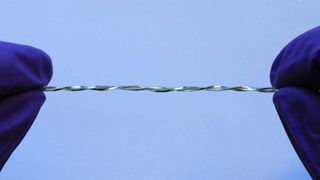The next generation of wearables could be created from touch-sensitive fibers
Soft and stretchable

There's little doubt that wearables will be a major part of the way we interact with technology in the future. But present-day wearables are problematically rigid - to become a bigger part of our lives, they'll need to become more like everyday clothing and less like jewelry for special occasions.
Materials engineers know this, and for years they've been working on ways to make electronics more flexible.
Now, a team of researchers from North Carolina State University have taken a step closer with the creation of elastic, touch-sensitive fibers that can interface with electronic devices.

“Touch is a common way to interact with electronics using keyboards and touchscreens,” said Michael Dickey, corresponding author of a paper describing the technology, published in the journal Advanced Functional Materials.
How they work
The fibers work by twisting together three strands of tube-like polymers with a liquid metal alloy in their centre - each strand a little wider than a human hair. One is totally filled with the alloy, one two-thirds filled and one only one-third filled.
When a human finger moves along the fiber, it comes into contact with different strands and the capacitance between the finger and the alloy changes, telling a connected system which part of the fiber is being touched.
You can see it in action here:
Get daily insight, inspiration and deals in your inbox
Sign up for breaking news, reviews, opinion, top tech deals, and more.
Soft Robotics
As well as future wearables, it's hoped that the technology could be used in soft robotics and other applications where elasticity is important, especially as the fibers can integrate with existing textiles and are easy to mass-produce at high speeds.
“We have created soft and stretchable fibers that can detect touch, as well as strain and twisting," said Dickey.
"These microscopic fibers may be useful for integrating electronics in new places.”













